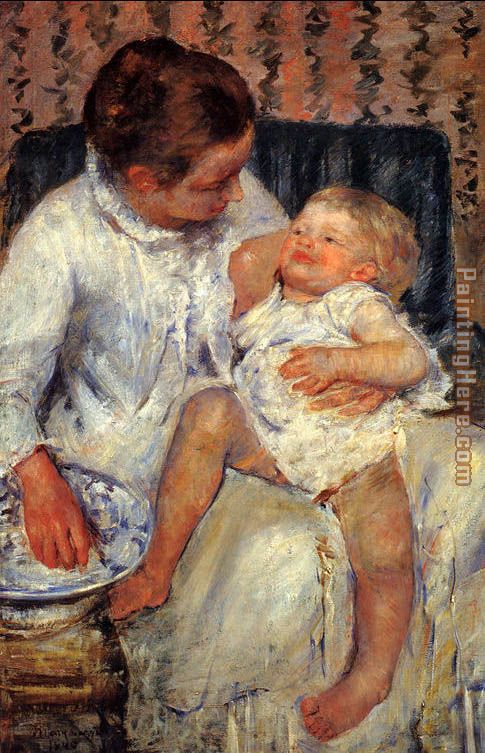Thursday I taught the last art class on Mary Cassatt; and posted the info. here on our current page for any who might be interested to read what my research turned up. During the drawing portion of the class, we did blind contours, upside down drawings, and ellipses. Then we drew simple objects--cylindrical bottles I had brought in. Then if they mastered that--they could add a light source. I had a great time revisiting artists that I hadn't focused on for a while. In a way, I wish I did more art classes for just this reason---maybe in the future??? Anyway, if you want to see the rest of the class material--go to the side bar on the right and look for 2013--September--Sept. 29th--"Masters Art Class for Surf Students fall 2013"
Mary Cassatt

Mother About to Wash Her Sleeping Child
(Surf Drawing Class 6 ---the last class)
Mary Cassatt (May 22, 1844 to June 14,1926. 82
yrs old), American painter, lived most in France, Impressionist.
The painting
of hers that I chose to pick to focus on is titled: Mother About to Wash Her
Sleepy Child; 1880: oil on canvas; 39 ½ x 251/8 in. The reason I picked this particular painting
is that this is her FIRST painting of a mother-and-child theme; which was to
become (after this painting) her trademark.
Just like Caravaggio and his dramatic painting style (chiaroscuro),
or Leonardo da Vinci’s style (sfumato),
or Georgia’s flowers, or Frida’s passionate feelings on display for all to
see---Cassatt became famous for painting genuine sentiment of love and care
between mothers and their children---in a way….that had never been done in a
way quite like she did it!!!
A little
detail about whom Mary Cassatt was—and how she became the only American painter
to become an established member of the French impressionist movement. She was born on May 22, 1844 (43 years before
Georgia O’Keefe) in Allegheny City, PA. to a very well to do real estate and
investment broker, and her childhood was typical of his social standing. There were advantages and disadvantages to
being from such a wealthy family. The
advantage was that at the age of 16 she began to study with private art lessons
in the Louvre, where she would study and copy masterpieces. She traveled and lived in Europe; especially
Paris, France—travel was considered part of her education; such as learning to
draw and speak German and French. But,
her dominate father did NOT approve of her being a “bohemian” artist. He would never approve or pay for any
expenses regarding anything art related—just for her living expenses. When she
was 15 years old she began attending the Pennsylvania Academy of the Fine Arts
and ended in 1865; which was the duration of the Civil War.
When she was
24 years old; one of her portraits was selected to be shown in a elite Paris
salon (art gallery); which would have been a very big deal for her. But then 2 years later she had to return to
PA because of the Franco-Prussian War breaking out in Europe. Her father made her life very difficult back
at home; and she eventually accepted a artistic commission to return to Europe.
Wasting no
time to get back to painting; the Paris Salon accepted her work starting in
1872- which established her as a legitimate artist—and not some hobbyist. 1877 was the first time in 7 years she had no
works in the salon; and it was at this time that she was invited by Edgar Degas
to show her works with the Impressionists.
(Who are the Impressionists? A
group of artists at the time that broke out of the current style of painting
and tended to prefer open air painting and the application of vibrant color in separate
strokes with little pre-mixing, which results in an “Impressionistic” view of
what you are seeing in the painting.)
Cassatt
gladly accepted the invitation from Degas, whom she had long admired. She began preparing paintings for the 1879
show. They became good friends, and he
influenced Cassatt greatly through the years (pastels, etchings, Japanese
influences, and perspective). She remained
an active member of the Impressionists until 1886; then her style evolved and
she moved to a more straightforward approach.
She no longer considered herself part of any movements but instead
actively experimented with a variety of techniques. The 1890’s are her most busy and creative
time.
In 1915 she
had to stop painting because diabetes stole her vision; and she lived the
remaining 11 years, until her death,
bitter and unhappy that she couldn’t do
what was her greatest source of pleasure; paint. Mary never married or seemed the least bit
interested in anything but her family and her art. Her family came to live with her in France; and
she took care of them. She faced many
restrictions because she was a woman in this particular time period. She wasn’t allowed to go the café’s with the
other male artists—her good friend, Degas.
She couldn’t take any figure drawing classes where there were nude
models. She worked well around all the
limits society and her family imposed upon her and succeeded extraordinarily.
Lastly, a
quote from her: “O how wild I am to get to work, my fingers farely itch and my
eyes water to see a fine picture again.”